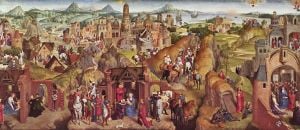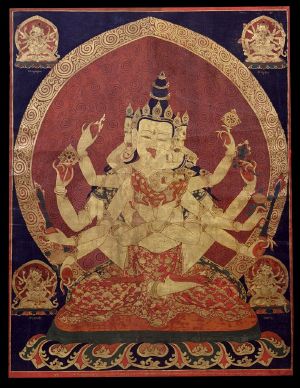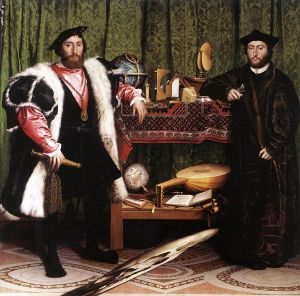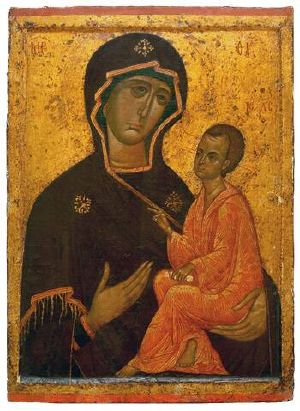Iconography
- This article is concerned with the methodology of iconography, principally in art history; for other uses of the term, primarily in Eastern Christianity, see Icon.
Iconography is the branch of art history which studies the identification, description, and the interpretation of the content of images. The word iconography literally means "image writing," or painting, and comes from the Greek εικον (image) and γραφειν (to write). A secondary meaning is the painting of icons in the Byzantine and Orthodox Christian tradition. The term is also used in many academic fields other than art history, for example semiotics and media studies, and in general usage, for the content of images, the typical depiction in images of a subject, and related senses. Sometimes distinctions have been made between Iconology and Iconography, although the definitions and so the distinction made varies.
Iconography as a field of study
Foundations of iconography
Early Western writers who took especial note of the content of images include Giorgio Vasari, whose Ragionamenti, interpreting the paintings in the Palazzo Vecchio in Florence, reassuringly demonstrates that such works were difficult to understand even for well-informed contemporaries. Gian Pietro Bellori, a seventeenth-century biographer of artists of his own time, describes and analyzes, not always correctly, many works. Lessing's study (1796) of the classical figure Amor with an inverted torch was an early attempt to use a study of a type of image to explain the culture it which it originated, rather than the other way round.[1]

Iconography as an academic art historical discipline developed in the nineteenth-century in the works of prominent French scholars such as Adolphe Napoleon Didron (1806–1867), Anton Heinrich Springer (1825–1891), and Émile Mâle (1862–1954),[3] all specialists in Christian religious art—the main focus of study in this period.[1] They looked back to earlier attempts to classify and organize subjects encyclopedically—like Cesare Ripa's Iconologia and Anne Claude Philippe de Caylus's Recueil d'antiquités égyptiennes, étrusques, grècques, romaines et gauloises—as guides to understanding works of art, both religious and profane, in a more scientific manner than the popular aesthetic approach of the time.[3] These early contributions paved the way for encyclopedias, manuals, and other publications useful for identifying the content of art. Mâle's l'Art religieux du XIIIe siècle en France (originally 1899, with revised editions) translated into English as The Gothic Image, Religious Art in France of the Thirteenth Century has remained continuously in print.
Twentieth-century iconography
In early-twentieth century Germany, Aby Warburg (1866–1929) and his followers Fritz Saxl (1890–1948) and Erwin Panofsky (1862–1968) elaborated the practice of identification and classification of motifs in images to using iconography as a means to understanding meaning.[3] Panofsky codified an influential approach to iconography in his 1939 Studies in Iconology, defining it as "the branch of the history of art which concerns itself with the subject matter or meaning of works of art, as opposed to form."[3] The distinction drawn by Panofsky and his students between particular definitions of "iconography" (put simply, the identification of visual content) and "iconology" (the analysis of the meaning of that content), has not been generally accepted, though it is still used by some writers.
In the United States, where Panofsky immigrated in 1931, students such as Frederick Hartt, and Meyer Schapiro continued under his influence in the discipline.[3] In an influential article of 1942, Introduction to an "Iconography of Mediaeval Architecture",[4] Richard Krautheimer, a specialist on early medieval churches and another German emigré, extended iconographical analysis to architectural forms.
From 1940 iconography became especially prominent in art history.[5] Whereas most iconographical scholarship remains highly dense and specialized, some analyses began to attract a much wider audience. Notable examples include Panofsky's theory (now generally out of favor with specialists) that the writing on the rear wall in the Arnolfini Portrait by Jan van Eyck turned the painting into the record of a marriage contract. Holbein's The Ambassadors has been the subject of books for a general market with new theories as to its iconography,[6] and the best-sellers of Dan Brown include theories, disowned by most art historians, on the iconography of works by Leonardo da Vinci.
Technological advances allowed for the creation of huge collections of photographs, with an iconographic arrangement or index, which include those of the Warburg Institute and the Index of Christian Art at Princeton (which has made a specialism of iconography since its early days in America).[7] These are now being digitized and made available online, usually on a restricted basis.
With the arrival of computing, the Iconclass system, a highly complex way of classifying the content of images into 28,000 classification types, and 14,000 keywords, was developed in the Netherlands as a standard classification for recording collections. Assembling huge databases allow the retrieval of images featuring particular details, subjects or other common factors. (As an example of the Iconclass code, "71H7131" is for the subject of "Bathsheba (alone) with David's letter"; "71" is the code for the whole "Old Testament" and "71H" the "story of David".) A number of collections of different types have been classified using Iconclass, notably many types of old master print, the collections of the Gemäldegalerie, Berlin and the German Marburger Index. These are available, usually on-line or on DVD.[8][9] The system can also be used outside pure art history, for example on sites like Flickr.[10]
Brief survey of iconography

Iconography in religious art
Religious images are used to some extent by all major religions, including both Indian and Abrahamic faiths, and often contain highly complex iconography, which reflects centuries of accumulated tradition.
Iconography in Indian religions
Central to the iconography and hagiography of Indian religions are mudra or gestures with specific meanings. Other features include the aureola and halo, also found in Christian and Islamic art, and divine qualities and attributes represented by asana and ritual tools such as the dharmachakra, vajra, dadar, phurba, sauwastika. The symbolic use of color to denote the Classical Elements or Mahabhuta and letters and bija syllables from sacred alphabetic scripts are other features. Under the influence of tantra art developed esoteric meanings, accessible only to initiates; this is an especially strong feature of Tibetan art.
Although iconic depictions of a single figure are the dominant type of Buddhist image, large stone relief or fresco narrative cycles of the Life of the Buddha, or tales of his previous lives, are found at major sites like Sarnath, Ajanta, and Borobudor, especially in earler periods. Conversely, in Hindu art, narrative scenes have become rather more common in recent centuries, especially in miniature paintings of the lives of Krishna and Rama.
Christian iconography
Christian art began, about two centuries after Christ, by borrowing motifs from Roman Imperial imagery, classical Greek and Roman religion and popular art; the motif of Christ in Majesty owes something to both Imperial portraits and depictions of Zeus. In the Late Antique period iconography began to be standardized, and to relate more closely to Biblical texts, although many gaps in the canonical Gospel narratives were plugged with matter from the apocryphal gospels. Eventually the Church would succeed in weeding most of these out, but some remain, like the ox and ass in the Nativity of Christ.
After the period of Byzantine iconoclasm iconographical innovation was regarded as unhealthy, if not heretical, in the Eastern Church, though it still continued at a glacial pace. More than in the West, traditional depictions were often considered to have authentic or miraculous origins, and the job of the artist was to copy them with as little deviation as possible. The Eastern church also never accepted the use of monumental high relief or free-standing sculpture, which it found too reminiscent of paganism. Most modern Eastern Orthodox icons are very close to their predecessors of a thousand years ago, though development, and some shifts in meaning, have occurred; for example the old man wearing a fleece in conversation with Saint Joseph usually seen in Orthodox Nativities seems to have begun as one of the shepherds, or the prophet Isaiah, but is now usually understood as the "Tempter" (Satan).[11]
In both East and West, numerous iconic types of Christ, Mary and saints and other subjects were developed; the number of named types of icons of Mary, with or without the infant Christ, was especially large in the East, whereas Christ Pantocrator was by far the commonest image of Christ. Especially important depictions of Mary include the Hodegetria and Panagia types. Traditional models evolved for narrative paintings, including large cycles covering the events of the Life of Christ, the Life of the Virgin, parts of the Old Testament, and, increasingly, the lives of popular saints. In the West especially, a system of attributes developed for identifying individual figures of saints by a standard appearance and symbolic objects held by them; in the East they were more likely to identified by text labels.
From the Romanesque period sculpture on churches became increasingly important in Western art, and in part because of the lack of Byzantine models, became the location of much iconographic innovation, along with the illuminated manuscript, which had already taken a decisively different direction from Byzantine equivalents under the influence of Insular art and other factors. Developments in theology and devotional practice produced innovations like the subject of the Coronation of the Virgin and the Assumption, both associated with the Franciscans, as were many other developments. Most painters remained content to copy and slightly modify the works of others, and it is clear that the clergy, by whom or for whose churches most art was commissioned, often specified what they wanted shown in great detail.
The theory of typology was often reflected in art, and in the later Middle Ages came to dominate the choice of Old Testament scenes in Western Christian art. Typology is the view that the meaning of events of the Old Testament can be understood as pre-figuring an event in the life Christ or the Virgin Mary.

Whereas in the Romanesque and Gothic periods the great majority of religious art was intended to convey often complex religious messages as clearly as possible, with the arrival of Early Netherlandish painting iconography became highly sophisticated, and in many cases appears to be deliberately enigmatic, even for a well-educated contemporary. The subtle layers of meaning uncovered by modern iconographical research in works of Robert Campin such as the Mérode Altarpiece, and of Jan van Eyck such as the Madonna of Chancellor Rolin and the Washington Annunciation lie in small details of what are on first viewing very conventional representations. When Italian painting developed a taste for enigma, considerably later, it most often showed in secular compositions influenced by Renaissance Neo-Platonism.
From the fifteentth century religious painting gradually freed itself from the habit of following earlier compositional models, and by the sixteenth century ambitious artists were expected to find novel compositions for each subject, and direct borrowings from earlier artists were more often of the poses of individual figures than of whole compositions. The Reformation soon restricted most Protestant religious painting to Biblical scenes conceived along the lines of history painting, and after some decades the Catholic Council of Trent reined in somewhat the freedom of Catholic artists.
Secular Western painting
Secular painting became far more common from the Renaissance on, developing its own traditions and conventions of iconography. These can be found in history painting, which includes mythologies, portraits, genre scenes, and even landscapes, not to mention modern media and genres like photography, cinema, political cartoons, comic books and anime.
Renaissance mythological painting was in theory reviving the iconography of the ancient world, but in practice themes like Leda and the Swan developed on largely original lines, and for different purposes. Personal iconographies, where works appear to have significant meanings individual to, and perhaps only accessible by, the artist, go back at least as far as Hieronymous Bosch, but became increasingly significant with artists like Goya, William Blake, Gaugin, Picasso and Joseph Beuys.
Iconography in disciplines other than art history
Iconography played a role in the development of tools to unpack the meaning of aspects of popular culture, and in the development of other academic disciplines including Semiotics, Anthropology, Sociology, Media Studies and Cultural Studies. These analyses in turn have affected conventional art history, especially concepts such as signs in semiotics. Discussing imagery as iconography in this way implies a critical "reading" of imagery that often attempts to explore social and cultural values. Iconography is also used within film studies to describe the visual language of cinema, particularly within the field of genre criticism.[12]
See also
Notes
- ↑ 1.0 1.1 Białostocki, 535
- ↑ Alte Pinakotek, Munich; (Summary Catalogue - various authors), (Edition Lipp, 1986, ISBN 3874907015), 348-51.
- ↑ 3.0 3.1 3.2 3.3 3.4 W. Eugene Kleinbauer and Thomas P. Slavens, Research Guide to the History of Western Art, Sources of information in the humanities, no. 2. (Chicago: American Library Association, 1982), 60-72.
- ↑ Richard Krautheimer, "Introduction to an "Iconography of Mediaeval Architecture," Journal of the Warburg and Courtauld Institutes, Vol. 5. (1942), pp. 1-33. Online text Retrieved May 30, 2008.
- ↑ Białostocki, 537
- ↑ Most recently: John North, The Ambassador's Secret: Holbein and the World of the Renaissance (Orion Books 2004).
- ↑ Białostocki, 538-39
- ↑ Iconclass website Retrieved May 24, 2008.
- ↑ Illuminated manuscripts from the Dutch royal Library, browsable by ICONCLASS classification and Ross Publishing - examples of databases for sale Retrieved May 24, 2008.
- ↑ Website Iconclass for Flickr Retrieved May 24, 2008.
- ↑ Schiller, 66
- ↑ Cook and Bernink (1999), 138-140.
ReferencesISBN links support NWE through referral fees
- Białostocki, Jan. The message of images: studies in the history of art. Vienna: IRSA, 1988. ISBN 9783900731083
- Cook, Pam and Mieke Bernink (eds.). 1999. The Cinema Book, 2nd ed. London: BFI Publishing. ISBN 9780394749860
- Schiller, G. Iconography of Christian Art, Vol. I. (English trans from German). London: Lund Humphries, 1971. ISBN 9780821203651
External links
All links retrieved February 19, 2018.
Credits
New World Encyclopedia writers and editors rewrote and completed the Wikipedia article in accordance with New World Encyclopedia standards. This article abides by terms of the Creative Commons CC-by-sa 3.0 License (CC-by-sa), which may be used and disseminated with proper attribution. Credit is due under the terms of this license that can reference both the New World Encyclopedia contributors and the selfless volunteer contributors of the Wikimedia Foundation. To cite this article click here for a list of acceptable citing formats.The history of earlier contributions by wikipedians is accessible to researchers here:
The history of this article since it was imported to New World Encyclopedia:
Note: Some restrictions may apply to use of individual images which are separately licensed.

